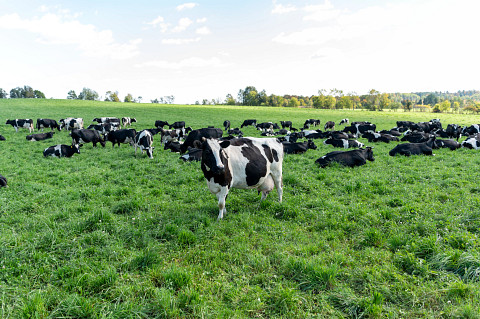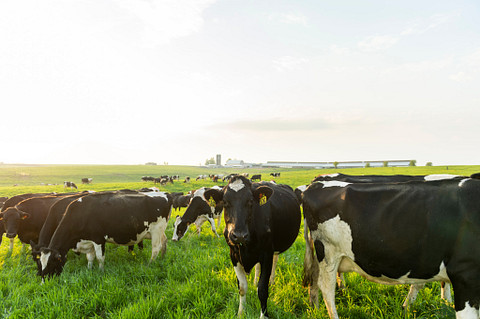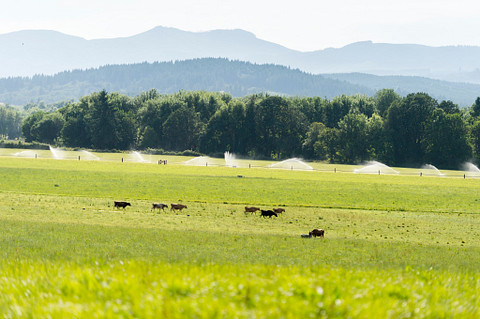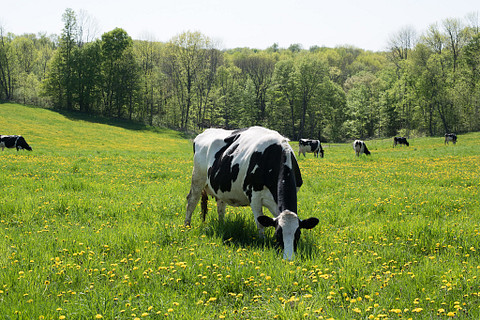Can Milk Be Climate-Neutral?
A growing number of dairy companies are trying to be climate-neutral, but is there a right way to get there?
Can Milk Be Climate-Neutral?
A growing number of dairy companies are trying to be climate-neutral, but is there a right way to get there?

submitted by Organic Valley.
It’s a dietary staple—beloved in a morning latte, the ingredient that makes mashed potatoes oh so creamy or a chocolate ganache worthy of topping a celebratory cake. It even saves those in need of giving their kids a quick dinner by getting mac and cheese to the right consistency. Yet, milk, specifically cow’s milk, contributes a lot to the greenhouse emissions of our food.
Livestock is responsible for anywhere from 11.1 percent to 19. 6 percent of greenhouse gas emissions, the majority of which come from cows raised for meat and milk products. Cows belch methane, a potent greenhouse gas that stays in our atmosphere for a much shorter time than carbon dioxide, about 12 years compared to thousands of years, but has much greater warming potential. One cow, for instance, burps about 220 pounds of methane in a year. As the planet warms, everyone from the IPCC to consumers to farmers and food producers is asking how to reduce those emissions—but what does that really mean?

“When you hear the term carbon neutral, that relates to industries that have carbon dioxide emissions,” says UC Davis professor and head of the agricultural research organization CLEAR Center at UC Davis Frank Mitloehner. “The cows are eating carbon-rich feed; they digest it, and when they digest it, they convert it to methane, and then they belch it out. So, what matters is that we manage methane and find ways to reduce it … Methane is only a problem if we don’t manage it and let it go into the atmosphere.”
In other words, to reduce emissions from the agricultural sector, many companies and scientists believe the answer is to capture or reduce methane and nitrous oxide, the other significant greenhouse gas from the farming industry. Yet, measuring how much methane and nitrous oxide to reduce is a source of debate—in part because we don’t have a good understanding of these terms and labels.
“One of the issues is the imprecise use of language many are interchanging between carbon-neutral and climate-neutral,” says Caspar Donnison, the author of a paper published in the journal Environmental Research Letters, on climate neutrality claims in the livestock sector.
Donnison says that, in order to have alignment with the Paris Agreement (keeping global warming to 1.5 degrees Celsius), there need to be significant methane reductions in the livestock sector, around 50 percent between 2020 and 2050. In contrast, the methane reductions proposed by some, such as studies he and his co-author scrutinized in their paper, are insufficient. Even with a proposed cut of 23 percent, livestock sectors would remain a source of very high emissions, sustaining a warming impact that is too high.
“It is a misleading use of the term ‘climate-neutral’ that is used in these studies, since under their definition the sector would still be causing global warming,” says Donnison. To actually maintain neutrality, Donnison says, the sector has to reduce enough to offset all the greenhouse gasses and other emissions for which it is responsible.
According to Donnison, there are large opportunities for the food sector to lower emissions, but they involve dietary shifts to plant-based foods, especially in areas with high meat consumption, and increased efficiencies in livestock production.

“About five years ago, I gave our sustainability director a goal for the farm to be carbon-neutral by the end of 2022 and expand that to the rest of the other farms that supply us by 2030,” says dairy farmer and president of Straus Family Creamery Albert Straus. The Straus family farm has been operating for more than 75 years, tucked along the coastline of Northern California. In 1994, Straus dairy farm became the first certified organic dairy farm west of the Mississippi River, and it was the first 100-percent certified organic creamery in the country.
The farm didn’t make its goal of carbon neutrality by 2022, but it is still working toward it. It has started testing a feed supplement with red seaweed, which has demonstrated a reduction in cow’s enteric methane emissions (which occur via cow burps) an average of 52 percent and as much as 90 percent, although there have been delays with availability recently. The Straus farm is one of a growing number of dairy companies, including Organic Valley and Neutral, which are trying to be climate-neutral and vying for sustainability motivated consumers in the process. But they each have different ways of going about it.
Along with the seaweed supplements, Straus has implemented a few new pieces of tech, including a methane digester that captures methane emissions from on-farm manure that would otherwise be released into the atmosphere and converts it into electricity. They are also working with other farms that supply the creamery; in 2023, Straus launched an incentive program to incorporate the practices he experimented with and perfected on his farm, so the whole dairy creamery supply chain can be carbon-neutral by 2030.
“I think it is essential for us to create a positive environment where our farms … can address climate change, can address healthy organic food for the local populations and regional populations, and help revitalize rural communities as well,” says Straus.
Start-up Neutral, which launched in 2019 in Oregon and Washington before expanding nationally in 2021, uses carbon offsets. Carbon offsets (when a company or individual calculates its carbon footprint and then funds projects that offset climate change, such as tree planting) have become controversial over the past few years because they rely on hard-to-verify data and tend to put the burden of fighting climate change on projects occurring in the global south. Still, for Neutral, it was a way to be climate neutral from the start while working with its suppliers to reduce emissions on farms.
“Our goal is to use fewer offsets as we implement more of our carbon reduction projects,” says Jake Schmitz, carbon reduction manager at Neutral Foods. “With a growing portfolio of emissions reduction projects, our goal is to cover as many reductions as possible through our own projects, resulting in a reduced use of offsets.”
To do that, Neutral is working with its farms to supplement cows’ feed with Agolin, an essential oil blend that the company says increases feed efficiency by more than four percent and reduces those burps by more than 8 percent. As Agolin helps farmers feed less, it should reduce N2O from crop production. It is also working to change the manure systems to separate solids and liquids, allowing farmers to distribute the manure more efficiently to cropland.

Organic Valley, a 1,600-farmer-owned cooperative, decided carbon offsets weren’t right for it.
“If we wanted to be carbon neutral tomorrow, we would have to buy carbon offsets because that’s how you get a lot done quickly,” says Nicole Rakobitsch, director of sustainability at Organic Valley. “Buying the carbon offsets from outside of your supply chain, though, means money goes to those projects that are not related to your commodity or the products that you’re making.”
On the facility side, Organic Valley has already pivoted to renewable electricity. Organic Valley, which has plans to be climate-neutral by 2050, decided to go with an approach called carbon insetting, which, according to Rakobitsch, means that, instead of purchasing offsets, it is using that money to invest in its suppliers and farmers.
Thanks in part to a USDA Climate-Smart Commodities grant, Organic Valley started a pilot program to provide technical assistance to farmers who want to implement a new practice, such as agroforestry, but don’t know where to start. Organic Valley pays its farmers annually per ton of carbon reduction to incentivize the farms.
There are pros and cons to all of these reduction methods; the methane digesters that are part of Straus’s and Neutral’s work to be climate-neutral have been touted by the Biden administration as a critical part of methane reduction, but there are questions about how effective they really are.
As the climate crisis intensifies, dairies who reduce their emissions are helpful, but only one part of an agricultural solution. As consumers look for more climate-friendly options, Donnison says to pay attention to the language companies use, to help avoid greenwashing. “It’s important to understand how companies are defining climate-neutral, and how they have calculated their emissions, as it can be misleading.”
Follow us
This work is licensed under a Creative Commons Attribution-NoDerivatives 4.0 International License.
Want to republish a Modern Farmer story?
We are happy for Modern Farmer stories to be shared, and encourage you to republish our articles for your audience. When doing so, we ask that you follow these guidelines:
Please credit us and our writers
For the author byline, please use “Author Name, Modern Farmer.” At the top of our stories, if on the web, please include this text and link: “This story was originally published by Modern Farmer.”
Please make sure to include a link back to either our home page or the article URL.
At the bottom of the story, please include the following text:
“Modern Farmer is a nonprofit initiative dedicated to raising awareness and catalyzing action at the intersection of food, agriculture, and society. Read more at <link>Modern Farmer</link>.”
Use our widget
We’d like to be able to track our stories, so we ask that if you republish our content, you do so using our widget (located on the left hand side of the article). The HTML code has a built-in tracker that tells us the data and domain where the story was published, as well as view counts.
Check the image requirements
It’s your responsibility to confirm you're licensed to republish images in our articles. Some images, such as those from commercial providers, don't allow their images to be republished without permission or payment. Copyright terms are generally listed in the image caption and attribution. You are welcome to omit our images or substitute with your own. Charts and interactive graphics follow the same rules.
Don’t change too much. Or, ask us first.
Articles must be republished in their entirety. It’s okay to change references to time (“today” to “yesterday”) or location (“Iowa City, IA” to “here”). But please keep everything else the same.
If you feel strongly that a more material edit needs to be made, get in touch with us at [email protected]. We’re happy to discuss it with the original author, but we must have prior approval for changes before publication.
Special cases
Extracts. You may run the first few lines or paragraphs of the article and then say: “Read the full article at Modern Farmer” with a link back to the original article.
Quotes. You may quote authors provided you include a link back to the article URL.
Translations. These require writer approval. To inquire about translation of a Modern Farmer article, contact us at [email protected]
Signed consent / copyright release forms. These are not required, provided you are following these guidelines.
Print. Articles can be republished in print under these same rules, with the exception that you do not need to include the links.
Tag us
When sharing the story on social media, please tag us using the following: - Twitter (@ModFarm) - Facebook (@ModernFarmerMedia) - Instagram (@modfarm)
Use our content respectfully
Modern Farmer is a nonprofit and as such we share our content for free and in good faith in order to reach new audiences. Respectfully,
No selling ads against our stories. It’s okay to put our stories on pages with ads.
Don’t republish our material wholesale, or automatically; you need to select stories to be republished individually.
You have no rights to sell, license, syndicate, or otherwise represent yourself as the authorized owner of our material to any third parties. This means that you cannot actively publish or submit our work for syndication to third party platforms or apps like Apple News or Google News. We understand that publishers cannot fully control when certain third parties automatically summarize or crawl content from publishers’ own sites.
Keep in touch
We want to hear from you if you love Modern Farmer content, have a collaboration idea, or anything else to share. As a nonprofit outlet, we work in service of our community and are always open to comments, feedback, and ideas. Contact us at [email protected].by Bridget Shirvell, Modern Farmer
January 25, 2024
Modern Farmer Weekly
Solutions Hub
Innovations, ideas and inspiration. Actionable solutions for a resilient food system.
ExploreExplore other topics
Share With Us
We want to hear from Modern Farmer readers who have thoughtful commentary, actionable solutions, or helpful ideas to share.
SubmitNecessary cookies are absolutely essential for the website to function properly. This category only includes cookies that ensures basic functionalities and security features of the website. These cookies do not store any personal information.
Any cookies that may not be particularly necessary for the website to function and are used specifically to collect user personal data via analytics, ads, other embedded contents are termed as non-necessary cookies.
I think in 50 years there will be some serious 🙄 reaction to this archived article. Come on people, oat milk is just as good, has a fraction of the impact on the environment, and you don’t have to make a mother mourn for her babies.